Echoes of Success: Case Studies in the Replication of Asian Development Bank Projects in the People’s Republic of China
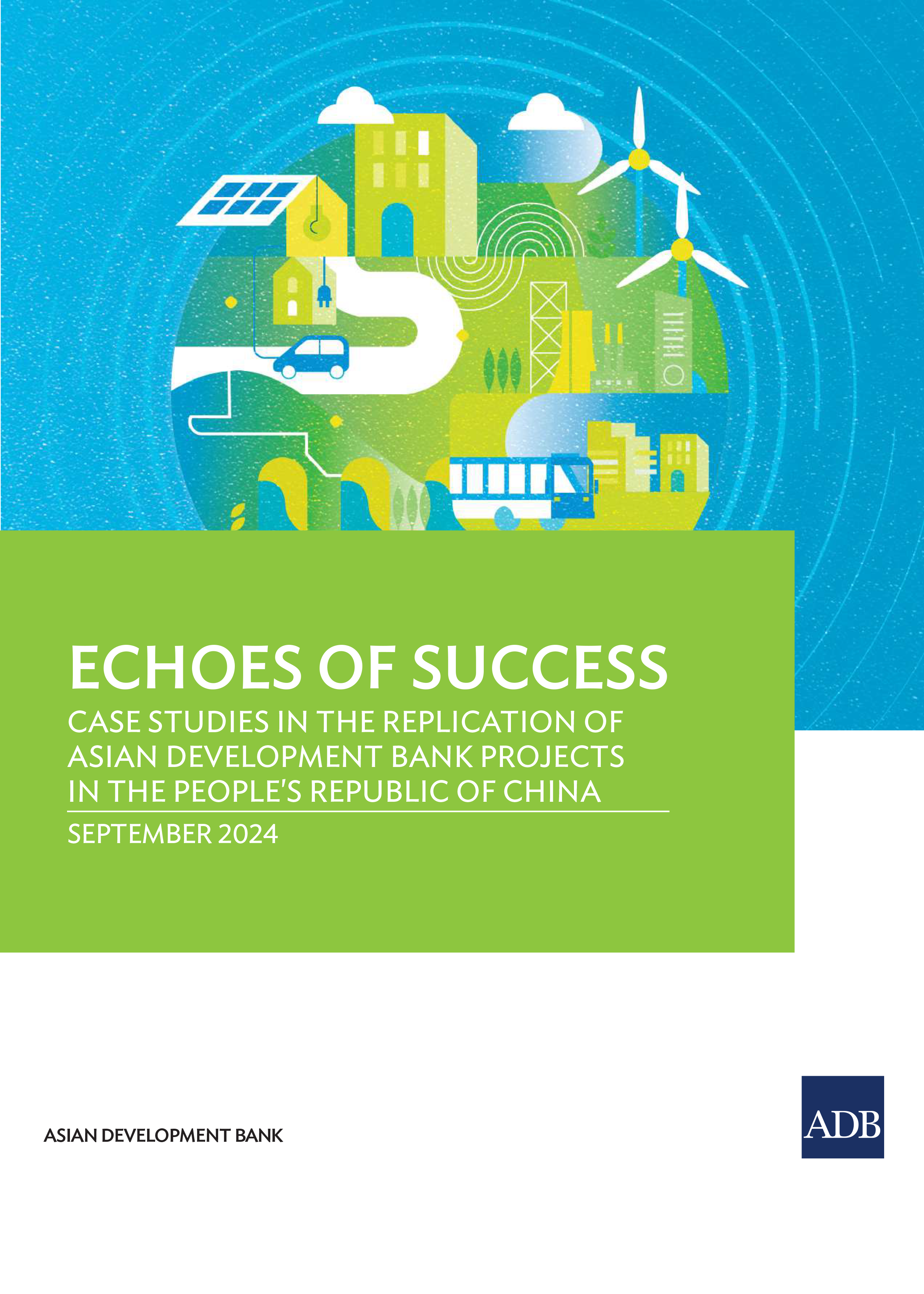



The global economy is rapidly changing, driven by emerging technologies that promote resource efficiency, inclusivity, and environmental sustainability. Digital technologies play a crucial role in this transformation, offering solutions to challenges like poverty, healthcare, job creation, and environmental protection. The COVID-19 pandemic has accelerated the adoption of digital tools, demonstrating their potential to connect people and businesses even in crises.
The CAREC region, however, faces significant challenges in harnessing the benefits of the digital economy due to inadequate digital infrastructure and unclear regulations. To address these issues, the CAREC Secretariat, supported by the Asian Development Bank (ADB) and partnering with the CAREC Institute and UNESCAP, developed the CAREC Digital Strategy 2030. This strategy serves as a roadmap for accelerating digital transformation and unlocking the region’s potential.
The CAREC Institute, with support from ADB and other organizations, has conducted research and engaged policymakers in dialogues on digitalization. Recognizing the importance of digital economy, the People’s Republic of China has made significant strides, with its digital economy value reaching 6.5 trillion US dollars by 2021.
To further promote digital economy in the CAREC region, the CAREC Institute will collaborate with ADB, the CAREC Secretariat, and Chinese government entities to launch a capacity building program aimed at enhancing digital economy cooperation and promoting digital connectivity. This initiative aligns with the CAREC Digital Strategy’s vision and mission, seeking to equip member countries with the necessary tools and knowledge to realize the full potential of the digital economy for inclusive economic growth, social well-being, and enhanced regional competitiveness.
| Morning | Opening Ceremony
Moderator: Gong Sen, Director, Center for International Studies on Development and Governance (CiSDG), Zhejiang University |
| CAREC Digital Strategy 2030 (Online) Dorothea Lazaro, Senior Regional Cooperation Specialist, ADB Central and West Asia Department CAREC Digital Economy Development: challenges and policy recommendations Rovshan Mahmudov, Senior Capacity Building Specialist, CAREC Institute |
|
| Afternoon | Practice and Pathway in China’s Development of Digital Economy Yuezhou Cai, Director and Researcher of the Digital Economy Research Office, Institute of Quantitative & Technical Economics at Chinese Academy of Social Sciences |
| Night | Ice-breaking:
|
| Morning | On-site: Zhejiang’s Information and Communication Infrastructure Construction China Mobile (Zhejiang) Innovation Research Institute China’s Information and Communication Infrastructure Construction: History and Experience Jun Lei, Senior Project Expert and Senior Engineer of the Smart Home Operations Centre and Integrated Communication Systems Department of China Mobile Ltd |
| Afternoon | The Application of Metaverse Technology in the Digital Economy Era Xuguang Zhang, President of the Zhejiang Association for Science, Technology and Innovation, Distinguished Researcher of the Intelligent Education Research Centre at Zhejiang University |
| Night | The New Generation of Artificial Intelligence: from AlphaGo to ChatGPT Fei Wu, Director and Qiu Shi Distinguished Professor of Institute of Artificial Intelligence at Zhejiang University |
| Morning | On-site: Evolution towards Intelligent Education Transformation Xianghu Future School and Hailiang Limited Co., Ltd. |
| Afternoon | On-site: Metaverse Technology, Digital Collectibles and Global Distribution of Digital Content Zhejiang Zoland Animation Co., Ltd. |
| Night | Practices, Experiences and Challenges in the Development of Digital Economy in Asian, CAREC and ASEAN Economies Yoonee Jeong, Senior Digital Tech Specialist (Digital Infra & Economy), Climate Change and Sustainable Development Department (CCSD), ADB |
| Morning | On-site: Cloud Computing: Current Landscape and Future Directions – From Emulation to Innovation Alibaba Cloud Computing Co., Ltd. – Hangzhou Branch |
| Afternoon | Intelligent Transformation of Manufacturing Industry Wenge Liu, Dean and Professor of the School of International Economics and Politics at Liaoning University |
| Morning | On-site: 3D+AI Tools for Propelling the Global Fashion Industry’s Digital and Innovative Evolution Zhejiang Linctex Digital Technology Ltd.(Style3D) |
| Afternoon | Exemplary Cases of Intelligent System Design Yongchuan Tang, Deputy Director of China Digital Creative Technology Equipment Innovation Industrial Alliance, Professor of the School of Computer Science and Technology at Zhejiang University |
| Night | Networking: Global Digital Economic Cooperation, Digital Economic Development Opportunities and Digital Technology Solutions (Arranged by the World Digital Economy Forum (WDEF), Hangzhou Digital Ecological Building and representative enterprises in the area of digital technology solutions) |
| Daytime | Digital Economy-focused Industry Tour to Shaoxing: Enterprise Digital Transformation, Rural Livestream E-commerce and Traditional Culture Zhejiang Toman Intelligent Technology Co., Ltd——Lunch——China Pearls and Jewelry International City——The China Shaoxing Wine Museum——Dinner (Arranged by Shaoxing Council of China Council for the Promotion of International Trade (CCPIT), Shaoxing Chamber of International Commerce and representative enterprises in Shaoxing) |
| Off | |
| Morning | Digitalization of Government Services for a Better Business Environment in China: A Case Study on the Reform Experience of Zhejiang Province Wenting Wei, Private Sector Specialist, World Bank in China The Construction Process of Digitalization of Government Services in Zhejiang Yongsheng Shen, General Manager of Zhejiang Daily Digital Technology (Zhejiang) Co.,Ltd., General Manager of Hangzhou City Brain Co.,Ltd. |
| Afternoon | On-site: Zhejiang’s Practice in Building a Digital Government: Hangzhou City Brain Zhejiang’s Practice in Intelligent Industrial Transformation: Zhejiang Top Cloud-agri Technology Co., Ltd |
| Morning | Sustainable Social Innovation and Governance of Digital Divide Lijie Fang, Professor of the School of Social Research at the Renmin University of China |
| Afternoon | Constructing Rules for an Opened Global Digital Economy System Xianhai Huang, Changjiang Distinguished Professor and Vice President of Zhejiang University |
| Night | Networking: Integration and Cooperation of Asian Civilisations in the Digital Age (Arranged by Zhejiang University International Business School (ZIBS) and the International Campus of Zhejiang University) |
| Morning | Financial Innovation in the Context of Digitalization – Micro Connect: The Wall Street for SMEs Zhong Wu, Secretary-General of the Finance Center for South-South Cooperation, Senior Advisor of Micro Connect and Chairman of Hong Kong Oriental Patron Financial Group |
| Afternoon | Networking: Global Trade of Cultural Goods and Services in the Digital Era (Arranged by the 20th China International Cartoon & Animation Festival (CICAF), Zhejiang Digital Culture International Cooperation Zone and representative enterprises in the area of international cultural goods and services) |
| Night | On-site: Digital Industry Investment and Live Streaming Economy |
| Morning | On-site: Zhejiang’s Footprint in E-commerce: A Dive into the Corporate Ecosystem and Development Experiences 1688.com and Taobao of Alibaba Group |
| Afternoon | Digital Transformation, Global FinTech Trends & Opportunities for Emerging Markets Shenglin Ben, Dean and Professor of the International Business School, Director of the Fintech Research Institute at Zhejiang University |
| Night | Networking: (Arranged by Zhejiang University International Business School (ZIBS), the International Campus of Zhejiang University and representative enterprises in Jiaxing) |
| Morning | Experiences and Practices in the Development of Digital Economy in CAREC and ASEAN Economies, Insights from the Workshop and Suggestions Group Reports by the Workshop Participants |
| Afternoon | Concluding Session and Commencement of the Workshop Sen Gong, Director and Professor of the Centre for International Studies on Development and Governance at Zhejiang and Zhejiang University (CiSDG) |
| Night | Closing Ceremony
|
| Daytime | Digital Economy-focused Industry Tour to Yiwu
|
| Off | |
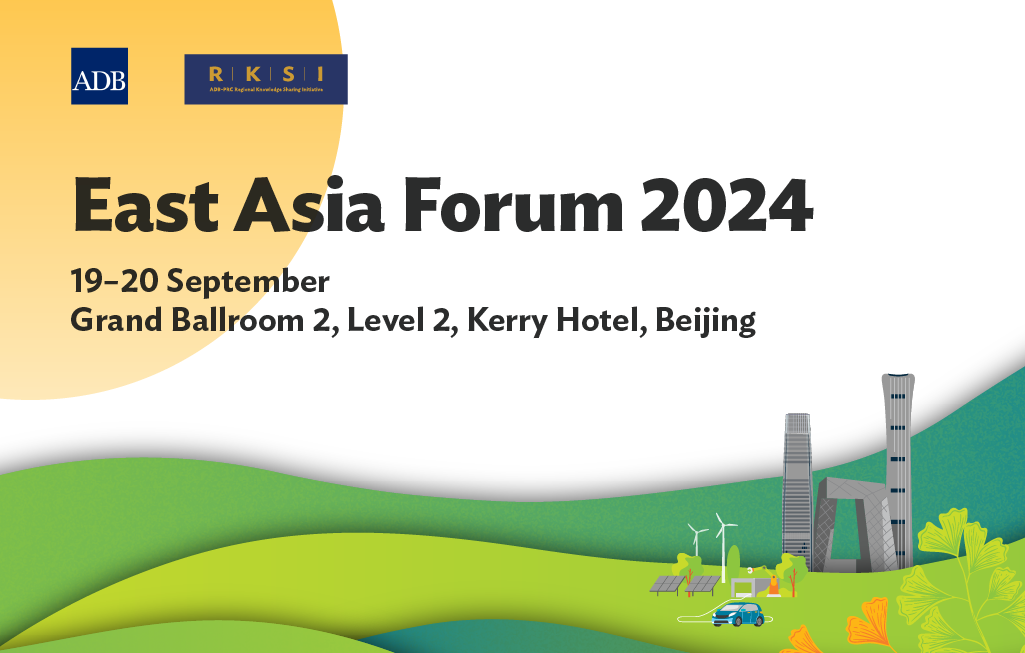

This year’s East Asia Forum (EAF) will explore ways the People’s Republic of China (PRC) and ADB can foster partnerships in addressing regional challenges related to climate change with a special interest in promoting global and regional public goods in ADB’s developing member countries (DMCs).
The Forum has four sessions. The first explores strategic ways the PRC and ADB can further evolve their partnership in tackling regional challenges including climate change. The second and third focus on two critical parts of climate as public goods and explore best practices for promoting them. Specifically, Session 2 focuses on nature conservation and ecosystem protection, and how instruments like nature-debt swaps can be a viable financing instrument to help DMCs meet their commitments to conserve 30% of terrestrial and marine areas by 2030. Session 3 centers on addressing climate mitigation through accelerating the energy transition from fossil fuel powered energy to clean energy, drawing on international practices related to energy policy, investments, and transition financing. The fourth session discusses how artificial intelligence can support addressing regional challenges. Specifically, it looks at emerging best practices in strategy, policy, and regulation to enhance the potential benefits of AI while mitigating its potential costs.
Each session will comprise a keynote speaker setting the context and regional challenges and followed by an interactive panel discussion comprising of distinguished experts.
In addition to the four sessions, ADB will also launch its publication “Echoes of Success: Case Studies in the Replication of Asian Development Bank Projects in the People’s Republic of China“. The report presents five ADB-financed projects in the PRC that have been replicated within and outside the PRC.
Venue: Grand Ballroom 2, Kerry Hotel, 1 Guang Hua Road, Beijing.
Browse the program and biographies here.
Download the presentations here.
| 09.00-18.00 | Field Visit to Project Site Tianjin Dongli Biomass Energy and Comprehensive Waste Treatment Subproject, Dongli District, Tianjin Municipality |
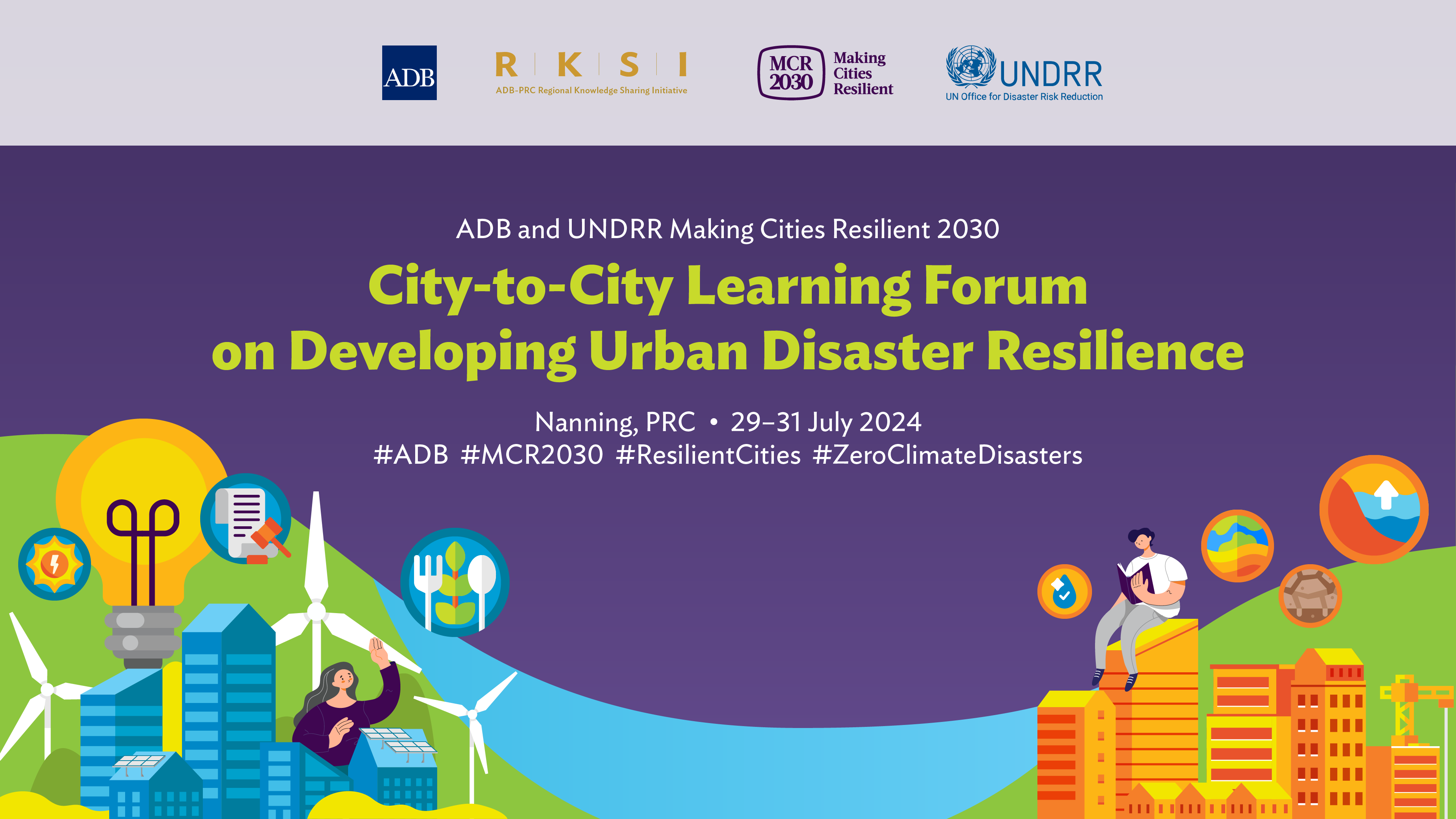

Cities and urban communities around Asia and the Pacific are facing an era of unprecedented uncertainty, with climate-induced disasters becoming more frequent, intense, and unpredictable. Over the past three decades, extreme weather events have accounted for 90% of all disasters, posing significant threats to urban areas through intensified storms, coastal flooding, deadly heatwaves, water shortages, and prolonged droughts. At the same time, local authorities face other systems-wide crises, in terms of water, food, and energy security. The Political Declaration of the midterm review of the Sendai Framework for Disaster Risk Reduction 2015–2030, adopted by the United Nations General Assembly in May 2023 reiterates the extreme challenges to hand and conveys a deep concern that the pace of implementation is not sufficient or equal. The gaps at the local and urban level are particularly large.
In response to these challenges, municipalities across Asia Pacific are scaling up their ambitions and actions on disaster resilience to protect their citizens and local infrastructure assets and systems. The Political Declaration of the midterm review of the Sendai Framework calls for scaled up support and action at the local level, urging countries to:
| Time | Program |
|---|---|
| 08:00 – 09:00 | Registration |
| 09:00 – 09:10 | Opening Remarks Norio Saito, Senior Director, Water and Urban Development Sector Office, Asian Development Bank (ADB) Sanjaya Bhatia, Head of Office Incheon, United Nation Office for Disaster Risk Reduction (UNDRR) (Online speaker) |
| 09:10 – 10:40 | Theme 1: Showcasing Urban Solutions – SDGs in Action at the Municipality Level Moderator: Mr Andy McElroy, Global Coordinator MCR2030, UNDRR Speakers: Ms Deborah C. Dacanay, Head of Quezon City Persons with Disability Affairs Office, Philippines – Quezon City Community Inclusive Disaster Preparedness Interventions (SDG 10 Reduced Inequalities) Ms Susana Sousa Gonçalves, Director of Civil Protection Matosinhos, Portugal – Putting Communities at the Heart of Resilience Action (SDG 11 Sustainable Cities and Communities) Ms Sung Ah An, Public Officer, Incheon Metropolitan City, Republic of Korea – How Incheon Effectively Manages Increasing Heatwave Risk (SDG 13 Climate Action) Q&A session |
| 10:40 – 10:55 | Coffee Break |
| 10:55 – 12:25 | Theme 2: Financing Urban Disaster Resilience Moderator: Mr Jinqiang Chen, Urban Development Specialist (Climate Change), Water and Urban Development Sector Office, ADB Speakers: Ms Liza Ramos, Research and Planning Division Head, Disaster Risk Reduction and Management Office, Makati City, Philippines – How is Makati Developing Innovative Financing Options for Resilience (Online speaker) Ms Jazlyn Lee, Engagement Lead for Southeast Asia & South Asia, Global Covenant of Mayors for Climate and Energy and the Gap Fund Partnership – Empowering Cities to Transform Climate Ideas into Action through the City Climate Finance Gap Fund Mr Thomas Kessler, Principal Finance Specialist (Disaster Insurance), ADB – Building Climate and Disaster Resilient Cities – Risk Management, Financing and Insurance Q&A session |
| 12:25 – 12:30 | Group Photo |
| 12:30 – 14:00 | Networking lunch |
| 14:00 – 15:30 | Theme 3: Learning from MCR2030 Resilience Hubs Moderator: Mr Alessandro Attolico, Executive Director of the Territorial Planning and Civil Protection Office at the Province of Potenza, Italy Speakers: Dr Kathy Oldham OBE, Chief Resilience Officer, Greater Manchester, the UK – How Greater Manchester Works with Nature as Part of Flood Risk Management (Online speaker) Mr Jieyong Luo, Resilient City Officer for the City of Zhuji, PRC – Building a Resilient River City – Zhuji’s Practice in Governing and Transforming Puyang River to Enhance Flood Resistance Mr Stefan Wagner, Head of the Department of International Affairs and Global Sustainability, City of Bonn, Germany – Connecting the Green Agenda from National to Local Level (Online speaker) Q&A session |
| 15:30 – 16:00 | Coffee break |
| 16:00 – 18:00 | Theme 4: Learning from Asian Development Bank Moderator: Ms Jingmin Huang, Director, Water and Urban Development Sector Office, ADB Speakers: Mr Khen Sopheak, Deputy Director of Inter-Sectoral Division of Kep Provincial Hall, Cambodia – City-to-City Partnership on Resilient City Development Ms Yingxia Xie, Former Vice President, Professor, China Academy of Urban Planning and Design – Urban Resilience Evaluation Method and Index System Ms Arpita Mozumder, Assistant Engineer, Planning Unit, Local Government Engineering Department, Bangladesh – Coastal Towns Climate Resilience Project in Bangladesh Mr Ming Hu, Senior Engineer, Director of Movement Control Office, Fuzhou Urban Water System Joint Drainage and Coordination Centre – One Center Manages the Entire City, Digitization Ensures Safety: Innovative Practices of the Fuzhou Water System’s Coordinated Management Mechanism Q&A session |
| 18:00 – 20:30 | Networking dinner |
| Time | Program |
|---|---|
| 09:00 – 10:30 | Theme 5: Strengthening National-Local Coordination Moderator: Ms Susana Sousa Gonçalves, Director of Civil Protection Matosinhos, Portugal Speakers: Mr Alessandro Attolico, Executive Director of the Territorial Planning and Civil Protection Office at the Province of Potenza, Italy – Long Term Strategy for Effective Risk Governance Mr Aslan Kandygulov, Director of the Center, Urban Environmental Sustainability Center, Astana, Kazakhstan – Resilience Action Plan for a 21st Century City Mr Ali Ahmed, Deputy Mayor, Kulhudhuffushi City Council, Maldives – Strengthening Local Capacity with MCR2030: A City’s Sustainable Approach to Building Resilience Q&A session |
| 10:30 – 10:45 | Coffee break |
| 10:45 – 12:15 | Theme 6: Identifying solutions to major urban disaster resilience challenges Moderator: Ms Deborah C. Dacanay, Head Persons with Disability Affairs Office, Philippines Speakers: Mr Hee Jong Kim, Director Ulsan Research Institute, Republic of Korea – Forging Multisector City Partnerships for Resilience Mr Thayukorn Prabamroong, Director of Climate Change, Mitigation, Adaptation Research Unit, Mahasarakham University, Thailand – How the Thai Network for Disaster Resilience of 17 Universities Supports Local Governments to Reduce Disaster Risk Ms Sofia Karma, Dr Chemical Engineer, Academic Staff National Technical University of Athens, Greece, Director of the European Center for Forest Fires, EUR-OPA Major Hazards Agreement/Council of Europe – Recommendations for Managing Urban Heatwaves and for Inclusivity in Disaster Preparedness and Response Q&A session |
| 12:15 – 13:30 | Networking lunch |
| 13:30 – 15:00 | Orientation: Disaster Resilience Scorecard Assessments for Cities Introduction: Orientation on two new self-assessment tools to understand capacities and gaps in terms of climate resilience and early warning systems. Group work: Participants will split into two groups and try out one of the tools. Plenary feedback: Participants will share feedback on their discussions and potential deeper dive follow-ups with individual cities will be discussed. |
| 15:00 – 15:15 | Coffee break |
| 15:15 – 17:15 | Final Session: Moving Forward on Urban Resilience in Asia Moderators: Mr Andy McElroy, Global Coordinator MCR2030, UNDRR Mr Jinqiang Chen, Urban Development Specialist (Climate Change), Water and Urban Development Sector Office, ADB Mr Xijie Lu, Urban Development Specialist, Water and Urban Development Sector Office, ADB -This moderated session will be a focused group discussion to identify priority areas for collaboration & collective commitment to ensure follow-up action on urban disaster resilience. -How can MCR2030 Resilience Hubs, Asian Development Bank, and cities work better together to strengthen urban disaster resilience – what plans/commitments can be made? -What kind of support is required to deliver on these plans/commitments? |
| 17:15 – 17:20 | Closing Remarks: Ms Jingmin Huang, Director, Water and Urban Development Sector Office, ADB |
| 18:00 – 20:30 | Networking dinner |
| Time | Program |
|---|---|
| 09:00 – 12:30 | Site visit to Guangxi Polytechnic of Construction – The Introduction of Guangxi Polytechnic of Construction, current status and the achievements of the Resilient Cities Development Research Center, Urban Renewal Research Center (Habitat Building Research Center) – Campus visit – Lunch at school cafeteria |
| 12:30 – 14:00 | Back to hotel |
| 14:00 – 17:50 | Site visit to Guangxi Institute of Safety and Technology – Visit the emergency service station in Xingdong Community, Nanning – Visit Guangxi Institute of Safety and Technology |
| 17:50 – 20:30 | Networking dinner |
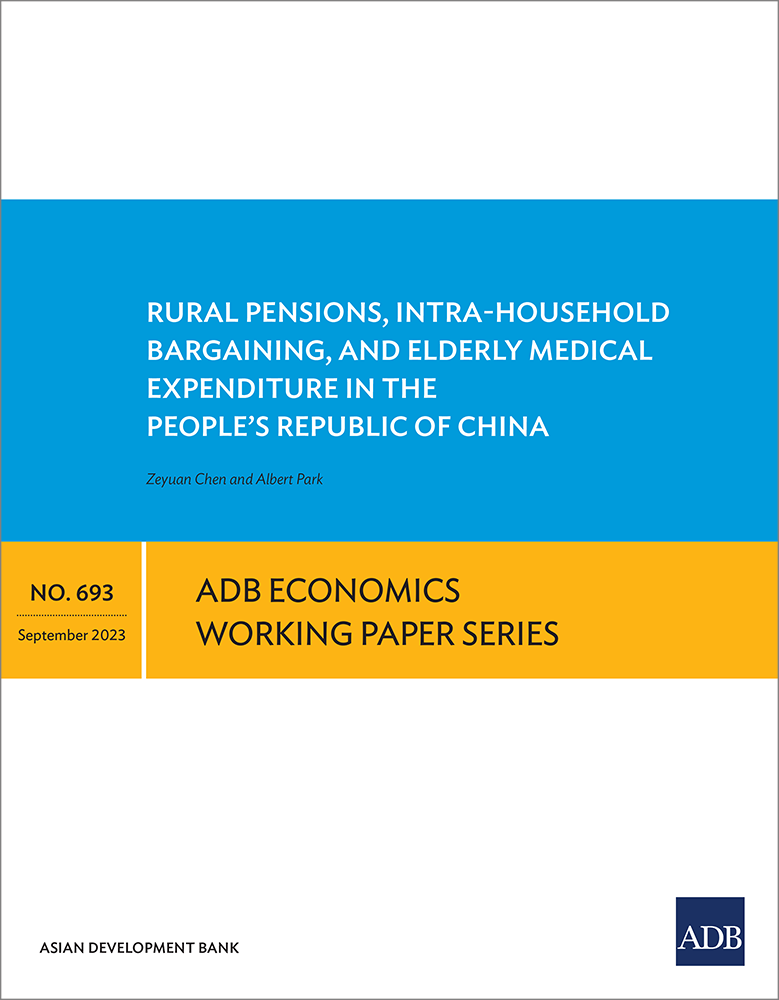
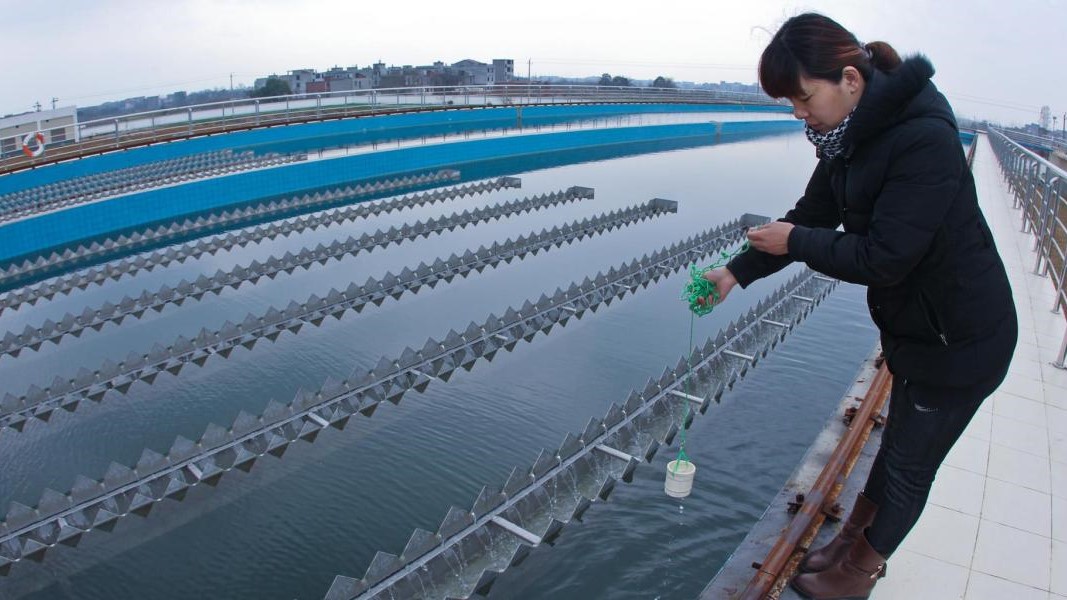

Water utilities in many cities in the People’s Republic of China may have achieved high level of cost recovery because of increased tariffs.
Introduction
Good tariff design is one of the key factors in enabling urban water and wastewater treatment systems to achieve full cost recovery and become financially independent. This requires in-depth tariff studies and financial and social analyses to inform policymaking, design tariff increases realistically, and gain public support for necessary reforms.
The experience of the People’s Republic of China (PRC) offers good practices in urban water and wastewater tariff reform for other countries in the region to consider. Since the late 1990s, the economic and enterprise reform programs of the PRC government required all water supply and wastewater management projects to be financially sustainable and capable of cost recovery. The Asian Development Bank (ADB) supported the government’s reform programs through water and wastewater tariff studies and helped finance water and sanitation projects to facilitate policy dialogue with the government and to assist water supply and wastewater treatment companies to achieve full cost recovery.
The Wuhan Wastewater and Stormwater Management Project, completed in 2015, demonstrates how cities can carry out water tariff reforms based on full cost recovery principles and considering local conditions. This article discusses in detail how a system approach to financial forecasting was used to determine a reasonable rate of return for the implementing agency, Wuhan Drainage Company (WDC), and to determine optimal tariff levels.
Three Water Tariff Studies
The preparation of the National Guidelines on Water Tariffs (NGWT) was a major output of the first of three water tariff studies funded by ADB. Promulgated by the National Development and Reform Commission (NDRC) and the Ministry of Construction (MOC) in September 1998, the NGWT reflects the following recommendations of the study: (i) selecting a tariff structure based on local conditions and priorities; (ii) adopting full cost recovery as the main objective in setting and approving tariff levels; (iii) using the public hearings mechanism to disseminate tariff increase plans to the public and obtain their feedback; and (iv) adopting a simplified process for tariff regulation, requiring evaluation and approval at the local municipal government level and supported by review and monitoring at the provincial and national level. The guidelines improved the long-term financial sustainability of the water supply companies and provided sufficient funds for operations and maintenance and service expansion, which would also help increase private sector participation in the water and wastewater sector.
Another water tariff study focused on assisting the government in developing institutional and technical capacities to implement the NGWT.
The PRC policy guidance on setting wastewater tariffs was amended in September 1999 by the government. It called for wastewater tariffs that are based on full cost recovery principles but allowed local governments the flexibility to decide when to adjust tariffs. Implemented between 2002 and 2003, ADB’s wastewater tariff study, the third study, contributed to this initiative to reform wastewater tariffs. The major output of the technical assistance was a detailed draft National Guidelines for Urban Wastewater Tariffs (NGWWT), including (i) Tariff Calculation Methodology, (iii) Model Agreement for Tariff Billing and Collection, (iv) Penalty and Administrative Remedies for Non-payment, and (v) Model Contract for Industrial Discharge to Sewer Network. MOC considered the recommendations in preparing the draft NGWWT to be approved by PRC State Council in 2005.
The Wuhan Project
Processed in 2005 and 2006, the wastewater and stormwater management project in Wuhan City entailed a total investment of $266.4 million, which included a $100 million loan from ADB. It was not a stand-alone investment but an integral part of the basin-wide Yangtze water resources management initiative, the Wuhan city urban development plan, the Wuhan municipal wastewater master plan, and the Wuhan stormwater drainage master plan. The Wuhan Municipal Government was implementing its wastewater master plan by installing additional wastewater treatment plants to achieve its target of 80% wastewater treatment rate by 2010.
In highlighting the project benefits, the Report and Recommendations of the President to the Board of Directors emphasized “improving cost recovery through a better tariff structure, with gradual increases to achieve cost recovery”, and “a demonstration impact on wastewater tariff reform in both the PRC and elsewhere in Asia.”
Historical tariffs. The tariff rates for water and wastewater (see Table 1) applied only to the seven central urban districts of Wuhan, and wastewater charges were based on actual water consumed. Wastewater tariff had not been introduced in suburban Caidian District, while 0.05 yuan/m3 wastewater tariff was levied on top of tap water sold in suburban Dongxihu District.
Table 1: Water and Wastewater Tariffs in Wuhan
| 1997 | 1998 | 1999 | 2000 | 2001 | 2002 | 2003 | 2004 | 2005 | |
|---|---|---|---|---|---|---|---|---|---|
| Wastewater tariff | |||||||||
| Resident | 0.160 | 0.176 | 0.192 | 0.208 | 0.400 | 0.400 | 0.800 | 0.800 | 0.800 |
| Public institutions | 0.160 | 0.176 | 0.192 | 0.208 | 0.400 | 0.400 | 0.800 | 0.800 | 0.800 |
| Industries | 0.160 | 0.176 | 0.192 | 0.208 | 0.400 | 0.400 | 0.800 | 0.800 | 0.800 |
| Operation and services businesses | 0.160 | 0.176 | 0.192 | 0.208 | 0.400 | 0.400 | 0.800 | 0.800 | 0.800 |
| Special industry | 0.160 | 0.176 | 0.192 | 0.208 | 0.400 | 0.400 | 0.800 | 0.800 | 0.800 |
| Water resources fee | |||||||||
| Resident | – | – | – | – | 0.010 | 0.010 | 0.010 | 0.010 | 0.010 |
| Public institutions | – | – | – | – | 0.010 | 0.010 | 0.010 | 0.010 | 0.010 |
| Industries | – | – | – | – | 0.020 | 0.020 | 0.020 | 0.020 | 0.020 |
| Operation and services businesses | – | – | – | – | 0.020 | 0.020 | 0.020 | 0.020 | 0.020 |
| Special industry | – | – | – | – | 0.020 | 0.020 | 0.020 | 0.020 | 0.020 |
| Tap water tariff | |||||||||
| Resident | 0.450 | 0.450 | 0.620 | 0.620 | 0.700 | 0.700 | 0.700 | 0.700 | 0.700 |
| Public institutions | 0.690 | 0.690 | 0.800 | 0.800 | 0.800 | 0.800 | 0.800 | ||
| Industries | 0.600 | 0.600 | 0.880 | 0.880 | 1.000 | 1.000 | 1.000 | 1.000 | 1.000 |
| Operation and services businesses | 1.000 | 1.000 | 1.460 | 1.460 | 1.700 | 1.700 | 1.700 | 1.700 | 1.700 |
| Special industry | 1.660 | 1.660 | 1.900 | 1.900 | 1.900 | 1.900 | 1.900 | ||
| End user combined tariff | |||||||||
| Resident | 0.610 | 0.626 | 0.812 | 0.828 | 1.110 | 1.110 | 1.510 | 1.510 | 1.510 |
| Public institutions | 0.882 | 0.898 | 1.210 | 1.210 | 1.610 | 1.610 | 1.610 | ||
| Industries | 0.760 | 0.776 | 1.072 | 1.088 | 1.420 | 1.420 | 1.820 | 1.820 | 1.820 |
| Operation and services businesses | 1.160 | 1.176 | 1.652 | 1.668 | 2.120 | 2.120 | 2.520 | 2.520 | 2.520 |
| Special industry | 0.160 | 0.176 | 1.852 | 1.868 | 2.320 | 2.320 | 2.720 | 2.720 | 2.720 |
Wuhan introduced a low wastewater tariff in 1997 and increased the tariff thereafter. When wastewater tariff was increased in 2003, the municipal government requested special subsidies for urban poor households recorded by the Wuhan Social Affairs Bureau.
The wastewater tariff of 0.80 yuan/m3 in Wuhan was relatively higher than many cities in the PRC as shown in Figure 1. Return on equity (ROE) for the WDC stood at 21.4%, 26.2%, and 19.7% from 2003 to 2005 respectively, showing full cost recovery achieved with the increased tariff at 0.80 yuan/m3. Many cities charged different wastewater tariffs for different water user categories. It appears a certain level of cost recovery, including full cost recovery for some cities and high-level cost recovery for other cities, would have been achieved among many cities in 2005 based on their tariff levels.
Figure 1: Resident Wastewater Tariff in Some Cities in 2005
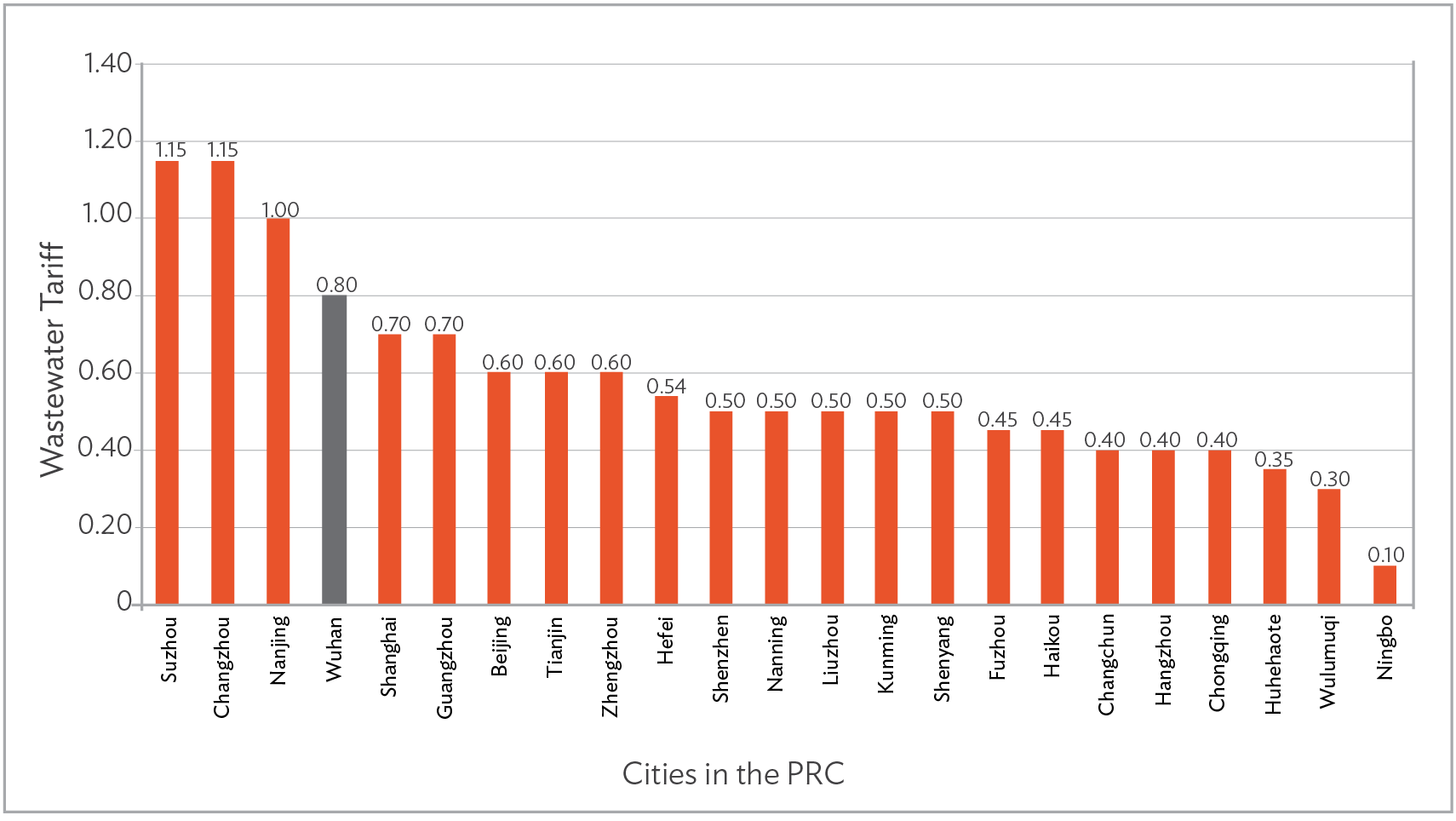
Methodologies. For each of the five wastewater treatment plants for the project, a financial cost–benefit analysis was conducted in real terms to determine weighted average cost of capital (WACC), financial internal rate of return (FIRR), and other indicators to assess financial viability of each plant (or subproject) and the incremental tariff required. For the three wastewater treatment plants in the central urban area, the incremental wastewater tariff assumed in the financial cost–benefit analysis was added to the existing wastewater tariff of 0.80 yuan/m3 in Wuhan, which will be levied on top of the water sold in the central urban areas, to arrive at the projected total wastewater tariff revenues for the implementing agency. For the two suburban wastewater treatment plants in Dongxihu and Caidian, which have different and much lower tariffs, the same financial cost–benefit analyses were conducted.
The wastewater tariffs in real terms used in the financial cost–benefit analysis for each of the five wastewater treatment plants were converted into nominal terms, and pro forma financial statements for each plant were separately prepared, projected, and analyzed.
Historical financial statements of WDC, the implementing agency for five wastewater subprojects, were analyzed, and projections were made. Financial statement projections, including income statement, balance sheet, and cash flow statement, were prepared in nominal price terms for a scenario without the project, taking into account major capital expenditures, associated operation and maintenance (O&M) costs, and other related costs and arrangements. Pro forma financial statement projections for the five wastewater treatment plants were consolidated into the financial statement projections for WDC for a scenario with the project.
The financial statement projections for WDC were prepared in nominal price terms and included inflation-adjusted costs and revenues for each year from 2006 to 2018. The consolidated financial statement projections were made to forecast the financial performance of the implementing agency, to assess profitability and debt service ability, and to test the tariff required for WDC to raise funds for project construction and achieve full cost recovery during operation.
Each wastewater treatment plant, or subproject, would normally require relatively higher incremental tariff, and different wastewater treatment plants would demand different tariff increases. All these needed to be tested in the whole system through the financial statement projections for WDC with due consideration to the tariff practice in Wuhan. Return on equity for WDC, based on the proposed tariff increase, would range from 6.0% to 21.4% during the project implementation until 2010 and from 4.3% to 7.5% when the project was operational from 2011 to 2018.
Further assessments and policy dialogue. The tariff arrived from the above analyses still cannot fully justify a proposed tariff increasing plan. Further assessments were needed, such as on customers’ willingness to pay the higher tariff and an affordability analysis. Pro-poor arrangements for urban poor households needed to be in place as well as measures to draw feedback on the planned increase and build public support for it.
Nonrevenue water (NRW), both technical loss and nontechnical loss, are important factors impacting the implementing agency’s financial performance. Reduced NRW due to improved engineering and tariff revenue collection had been assessed and incorporated into the financial cost–benefit analysis and the WDC’s financial statement projections.
For the Wuhan project, policy dialogue with government was proposed to support a realistic tariff reform program. Based on the analyses and assessments, it was recommended that wastewater tariff be increased in 6 years to 1.00 yuan/m3 from the current 0.80 yuan/m3.
Improved public awareness of the benefits accruing from effective drainage and treatment of wastewater significantly enhanced users’ willingness to pay wastewater charges. Socio-economic surveys undertaken during the loan processing indicated a significantly higher level of public willingness to pay, a positive indicator of public support for the project.
The tariff levels based on the principles of full cost recovery would enable WDC to become a financially autonomous and sustainable entity, and the availability of adequate funds for loan repayment, operations and maintenance, and eventual replacement of project facilities would be assured.
Findings in Project Completion Report by August 2015. The Wuhan Municipal Government held a public hearing on the tariff increase. Delayed by 2 years, the wastewater tariff was increased to 1.1 yuan/m3 in 2014 for urban residents, higher than suggested by ADB. The WDC complied with all financial covenants, which includes that “wastewater tariffs charged by WDC be set at a level that ensures cost recovery of operation and maintenance, depreciation and financial costs including the debt service obligations, and a reasonable profit margin for WDC.” The project is rated likely sustainable. Although there was delayed implementation for 1 WWTP, “the urban wastewater treatment rate in Wuhan reached 92.4% in 2010 and 93% in 2013.”
Current Water Tariff in Wuhan and Wastewater Tariff among Cities. The current water tariff in Wuhan is presented in Table 2.
Table 2: Water and Wastewater Tariff in Wuhan
(yuan/m3)
| Water | Wastewater | Combined | |
|---|---|---|---|
| Resident | 1.37 | 1.10 | 2.47 |
| Nonresident | 2.12 | 1.37 | 3.49 |
| Special industries | 8.10 | 1.37 | 9.47 |
Figure 2: Current Resident Wastewater Tariff in Some Cities
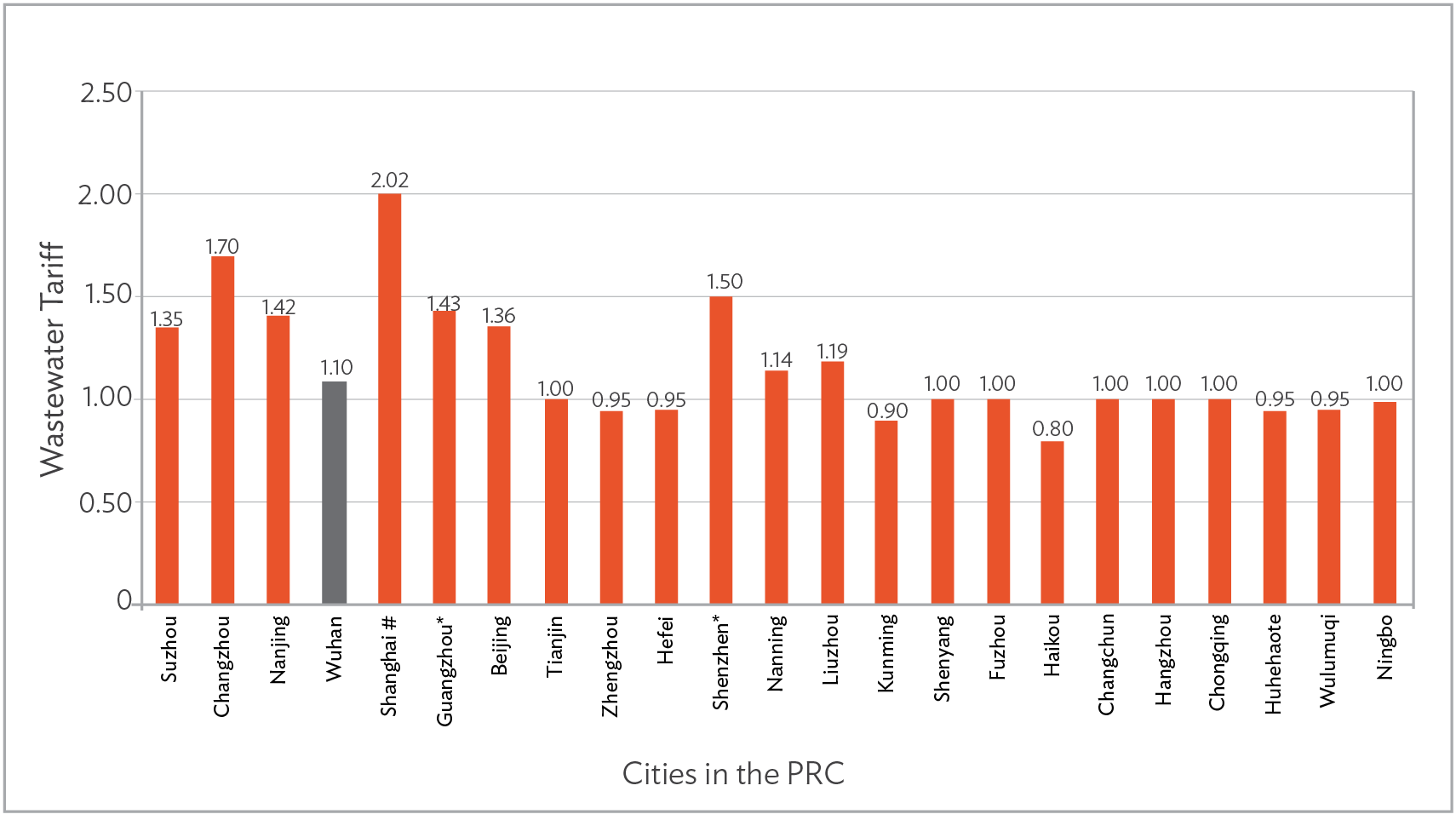
ADB’s first two water tariff studies were conducted when the gross domestic product (GDP) per capita in the PRC was at a low $609.66 in 1995 and $959.37 in 2000. This did not deter initiatives to reform the water and wastewater tariffs in the country with the objective of requiring full cost recovery from service providers. Figure 1 shows a high level of cost recovery would have been achieved in many cities because of increased wastewater tariffs when per capita GDP was about $1,753.42 in 2005. Figure 2 shows a high level of cost recovery, including full cost recovery for some cities, would have been achieved now among the cities.
In comparison, when per capita GDP in the Philippines was $1,741.60 in 2007 (Table 3 below), the combined water and wastewater tariff in Bonifacio Global City and Metro Manila was so high that full cost recovery should have already been achieved then. The Manila Water Company, Inc. provides water treatment, water distribution, sewerage, and sanitation services to more than six million people in the eastern side of Metro Manila (East Zone), which comprises a broad range of residential, semi-business, commercial. and industrial customers. The East Zone encompasses 23 cities and municipalities, spanning a 1,400-square kilometer area. The company is entitled to recover its operating, capital maintenance, and investment expenditures; business taxes; and concession fee payments over the concession period; and to earn a rate of return on these expenditures. Its return on equity from 2006 to 2020 ranged from 8.09% to 22.4%.
Table 3: GDP per Capita in Current Prices
(US$)
| 1995 | 2000 | 2005 | 2007 | 2010 | 2015 | 2020 | 2021 | |
|---|---|---|---|---|---|---|---|---|
| People’s Republic of China | 609.66 | 959.37 | 1,753.42 | 2,693.97 | 4,550.45 | 8,016.43 | 10,408.67 | 12,556.33 |
| Philippines | 1,222.29 | 1,073.26 | 1,245.29 | 1,741.60 | 2,201.78 | 2,974.30 | 3,224.42 | 3,460.53 |
Source: The World Bank.
Most water supply companies in the PRC are owned by the government. The Manila Water Company, a publicly listed company, is the concessionaire of the state-run Metropolitan Waterworks and Sewerage System. WDC and Manila Water Company achieved full cost recovery when per capita GDP was about $1,750 in the two countries.
Today, per capita GDP in most of developing Asia is around $1,750 or higher. Some countries even have a per capita GDP that is higher than $10,000. Yet, many water systems in the region are not financially sustainable and rely heavily on fiscal transfers and government subsidies despite improved economic well-being. Most water and sanitation projects are still justified based on their capacity to generate revenue to adequately cover O&M costs, and the government’s commitment to transfer adequate funds as necessary to cover such expenses.
With relatively higher inflation rates over the years, no increase in tariff in nominal terms means decreased tariff in real terms, further deteriorating the financial position of a water utility. This means the water utility will continue making demands on government’s scarce fiscal resources. It has no financial capacity for assets expansion or replacement to provide better services to the public.
Increased per capita GDP in a country normally improves the affordability profile, especially in its capital and major cities with relatively higher per capita GDP. When higher tariffs are affordable in a city, public support, willingness-to-pay, and pro-poor arrangement for poor households are sensitive and critical concerns before a water system can be moved up to a higher level of cost recovery. Continued policy dialogue with governments supported by a realistic tariff study and in-depth financial and social analyses, together with good practices in the water sector, would help build understanding and a better future for people and for countries.
Asian Development Bank (ADB). Wuhan Wastewater and Stormwater Management in the People’s Republic of China.

Former Senior Financial Management Specialist, Procurement, Portfolio and Financial Management Department, ADB
This blog is reproduced from Development Asia.
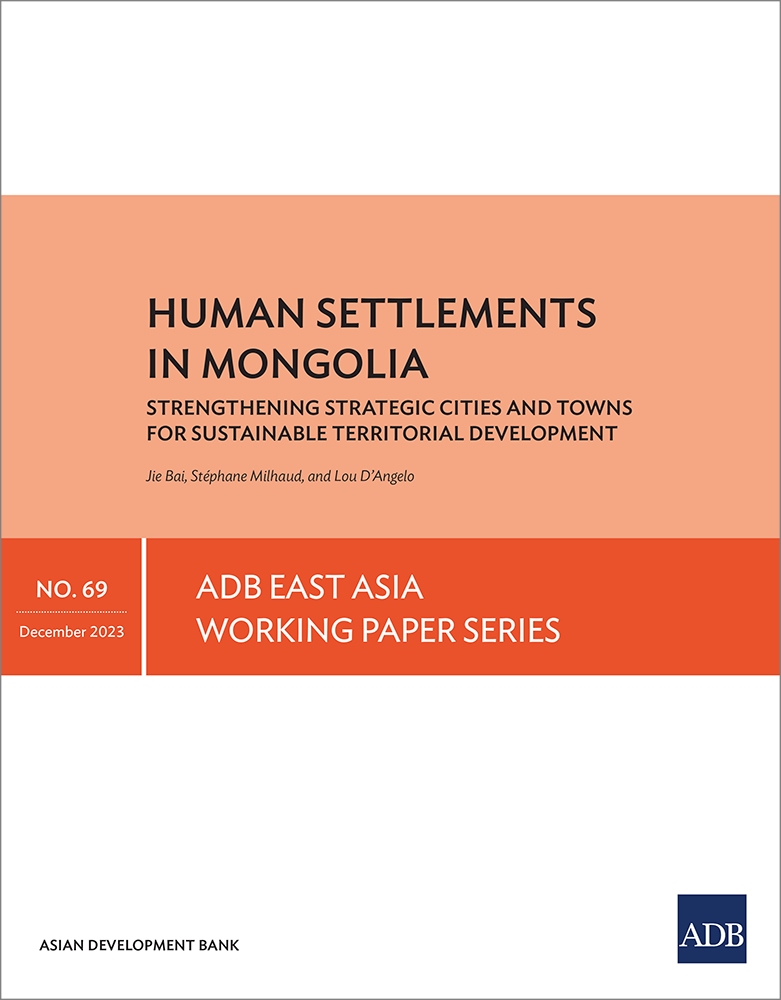
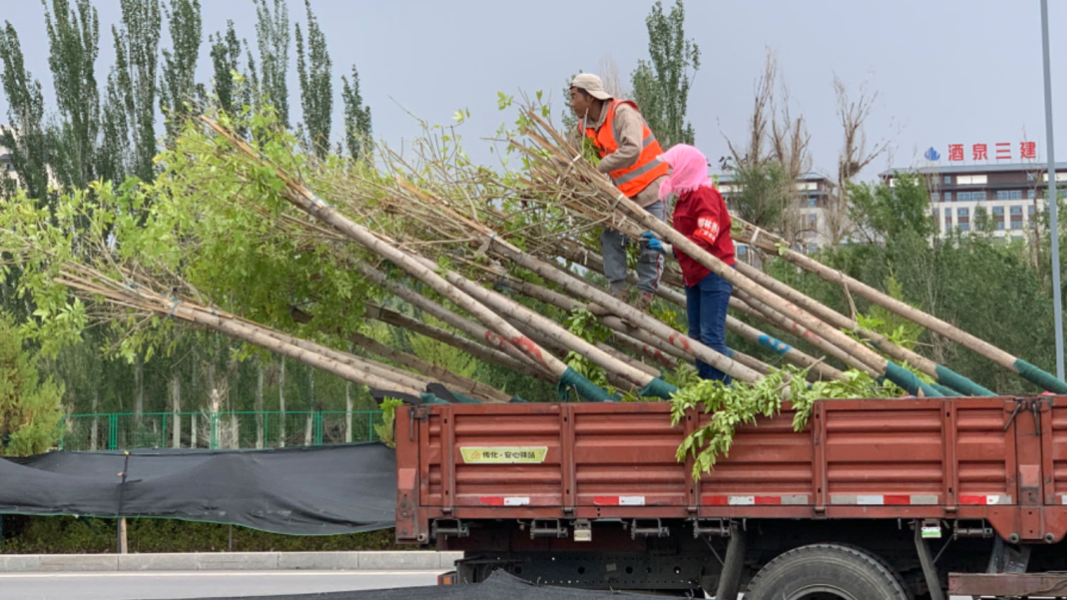
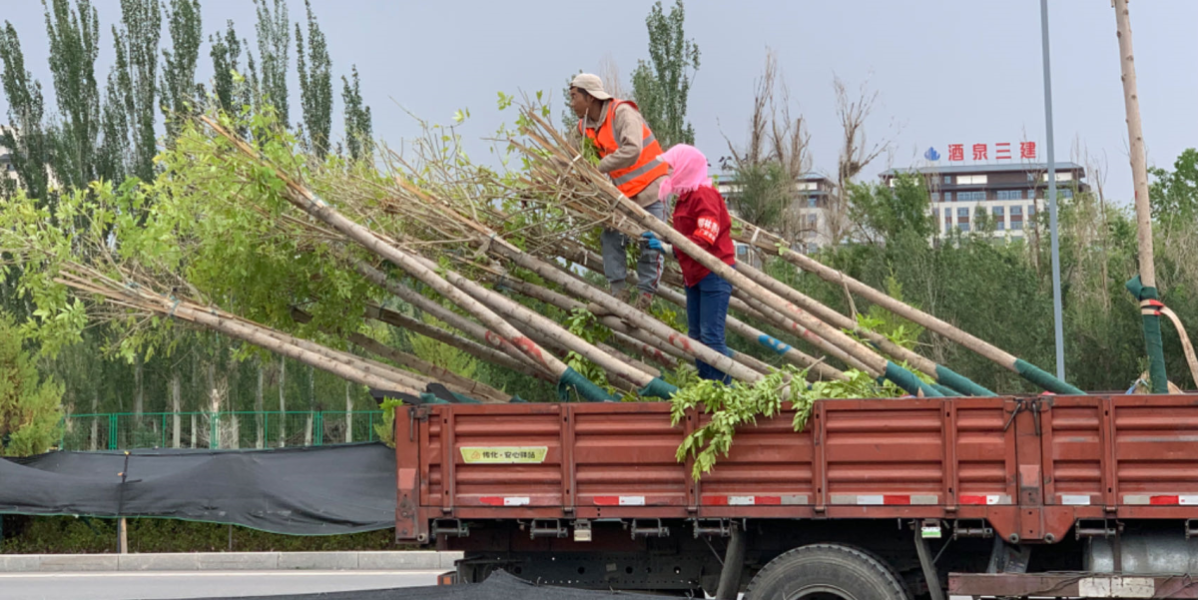
An integrated approach to sustainable and inclusive development helps an oasis city in the People’s Republic of China overcome environmental challenges.
Overview
Jiuquan was an oasis on the ancient Silk Road along the Hexi Corridor, an important trade route in the northwestern region of the People’s Republic of China (PRC). Located between the southern limits of the Gobi desert and the Qilian Mountains, this city in Gansu province has faced development challenges because of its harsh natural environment. Yet, it has a thriving economy, and it is expected to play a strategic role in the socioeconomic development of the region.
A project funded by the Asian Development Bank (ADB) supported Jiuquan city by implementing an integrated solution to promote environmentally sustainable and inclusive development through improvements in wastewater management, urban transport and related facilities, windbreak plantation, and other services. Climate change mitigation and adaptation measures were introduced in the project design to strengthen the city’s climate resilience and reduce carbon emissions.
The project also strengthened the capacity of the municipal government for sustainable urban planning and development.
Project information
Project snapshot
Context
Jiuquan is located about 730 kilometers (km) northwest of the provincial capital of Lanzhou. The city’s key industries are renewable energy equipment manufacturing and agricultural product processing. Tourism has increasingly contributed to the city’s economic output based on its rich historic and cultural resources, as well as its status as the launching site of the national space program.
The city has the potential to serve as a vital artery for the relatively less-developed northwestern region of the PRC. The National Strategy for Development of the Western Region sees the city as having a key role in aiding the region’s socioeconomic development.
Challenge
Jiuquan faces various environmental problems and urban development challenges. It has a continental desert climate with constrained water resources and high evaporation. Sand and dust are carried frequently by strong winds from the desert, causing atmospheric pollution, a high incidence of respiratory illness, and productivity losses.
Beida, the river that flows through Jiuquan, has been gradually polluted by discharges of untreated wastewater from the city. Its water quality is class II for the upstream reach of Jiuquan, class III through the city area, and class IV downstream.[1]
As a water-scarce city undergoing continuous growth, Jiuquan must stem the gradual contamination of its water resources, which endangers public health and safety and constrains its sustainable development.
The increasingly congested urban roads and inadequate infrastructure also limit the city’s ability to promote greater links along the Hexi Corridor and enable socioeconomic development in the northwestern region.
Solutions
The project supported the city in addressing its challenges through an integrated approach to improving the urban environment and by involving the local community in project design and implementation.
Expand windbreak tree screens. About 60.5 hectares (ha) of windbreak tree screens were planted along the northern and southern banks of the Beida River to reduce the city’s vulnerability to desertification, enhance public amenities, and improve the living environment and public health of residents.
A windbreak plantation education trail was set up to improve public awareness where visitors can learn about the city’s exposure to desertification, the challenges that Jiuquan faces in managing its water resources and air quality, and the benefits of afforestation in protecting the environment and improving the city’s resilience to climate change impacts.
Improve wastewater management and resources reuse. A wastewater treatment plant with a capacity of 60,000 cubic meters (m3) per day and a wastewater collection network with a total length of 44.2 km were constructed. About 18,000 m3 of reclaimed water is used daily for greening and irrigation of the windbreak plantation. Reclaimed water reuse will be increased to 30,000 m3 around 2025. Sludge after dewatering with water content below 60% is disposed to a sanitary landfill. A road map for sludge reuse—such as land improvement, soil conditioner for the windbreak trees plantation, or other agricultural uses, was developed and will be implemented in the near future.
Improve urban road network and facilities. In the expanded urban area, about 15.7 km of roads and two bridges were constructed and upgraded. Associated utility facilities , such as road lighting, pipes for water supply, wastewater, heating, and gas, and conduits for electricity and telecommunication lines, were installed. In the existing central urban area, traffic management and safety systems and 0.8 km of roads were upgraded.
Develop the municipal government’s capacity in urban planning and management. The project trained officials of Jiuquan municipal government and staff of the project implementing agencies in various aspects of urban planning and management. It developed and enhanced plans and strategies in water conservation, wastewater reuse, sludge management, urban transport system, traffic management and safety, and desertification risk management. It also promoted private sector participation to improve the efficiency of municipal services.
Promote local communities’ participation in project design and implementation.
Different groups of local communities were widely consulted to improve road design. Improvements included traffic lights; pedestrian crossings to ensure road safety, especially for children and older persons; and optimization of routes, frequencies, and hours of service as well as links to school and health services before new bus services were put into place.
Representatives were invited to participate in public hearings for wastewater and water tariffs to improve transparency. Water conservation advocacy campaigns were organized annually and delivered through public broadcasts, television, newspapers, the internet, brochures, booklets, billboards, and documentaries, reaching more than 100,000 beneficiaries to improve public awareness and behavior to support saving of water resources.
Results
Improved living conditions and urban infrastructure services.
About 450,800 residents, 218,100 (48%) of them women and 11,333 from low-income households, directly benefitted from the project. They have sustainable access to an improved road network and related services, wastewater management, and landscaped windbreak plantations.
There is now a road linking the high-speed railway station and the Western Suburbs Industrial Zone, reducing travel time at peak hours between the two spots to 25 minutes from 45 minutes. Improved traffic management contributed to substantial reduction in traffic fatality rate to less than 2.5 per 10,000 vehicles from 4.5.
The project provided windbreaks for the city against sandstorms, enhanced public amenities, and improved the living environment and public health of local residents, with additional benefits of carbon sequestration, sand fixation, secured agricultural production, soil conservation, and regulation of micro-climate.
Public satisfaction with the urban environment and ecology increased to 90.5% in 2020 from 84% in 2011.
Improved environment and climate resilience of the city.
The project generated significant environmental benefits. Wastewater collection and treatment rate increased to about 99% from 66%, pollutants discharge to the Beida River was dramatically reduced, and the water quality was improved to grade I from grade III.
Climate change mitigation and adaptation measures that were considered in the project design and carried out during implementation improved the city’s climate resilience. The windbreak forest created 10,104 tons of biomass, absorbed 2,678 tons of carbon dioxide, and released 1,983 tons of oxygen each year. The mitigation measures will gradually reduce the risk of increasing desertification in the long term. The bridges and associated culverts were designed as an adaptive measure against road flooding during torrential rain or heavy flooding with a 1-in-100-year return period. The reuse of the treated wastewater for greening and irrigating the windbreak forests was also an adaptive measure to conserve water resources.
Improved institutional capacity. The Jiuquan municipal government improved its institutional capacity in urban development planning. The strategies developed under the project became part of the city’s integrated long-term development plan.
Water sector management and governance were strengthened through enhanced water conservation and reuse and establishment of private–public partnership.
Public utilities improved their capacity in project design and implementation and assets management, and incorporated the inclusive participatory consultations with various stakeholders, including residents, into their operations.
Lessons
The project designed and implemented a comprehensive capacity building component that strengthened the municipal government’s institutional capacity in forming strategies for water conservation, resources reuse, traffic management and traffic safety improvement, and desertification risk management. This enhanced the project’s sustainability.
The inclusive and participatory approach in project design promoted social inclusion and equitable access to urban services.
To address the emerging challenges posed by climate change, mitigation and adaptation measures could be considered in the project design and carried out during implementation to improve a city’s resilience to impacts.
[1] The Water Quality Standards (GB 3838-2002) of the People’s Republic of China have five classes. Class I is pristine; class II is for high-value fish production areas and spawning habitats; class III is suitable for urban water supply; class IV is suitable for irrigation and recreation; and class V is polluted and not recommended for human consumption or agricultural use.
Asian Development Bank (ADB). 2022. Completion Report: Gansu Jiuquan Integrated Urban Environment Improvement Project in the People’s Republic of China. Manila.
ADB. 2013. Report and Recommendation of the President to the Board of Directors: Proposed Loan People’s Republic of China: Gansu Jiuquan Integrated Urban Environment Improvement Project. Manila.

Senior Project Officer, East Asia Department, ADB
This blog is reproduced from Development Asia.
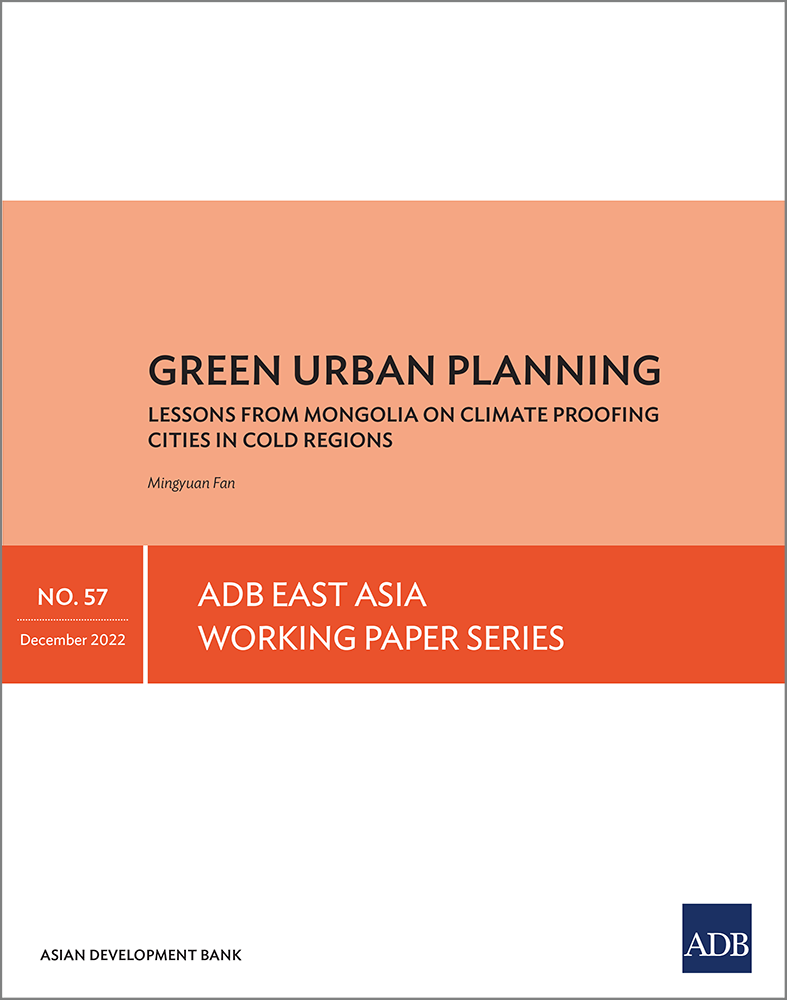
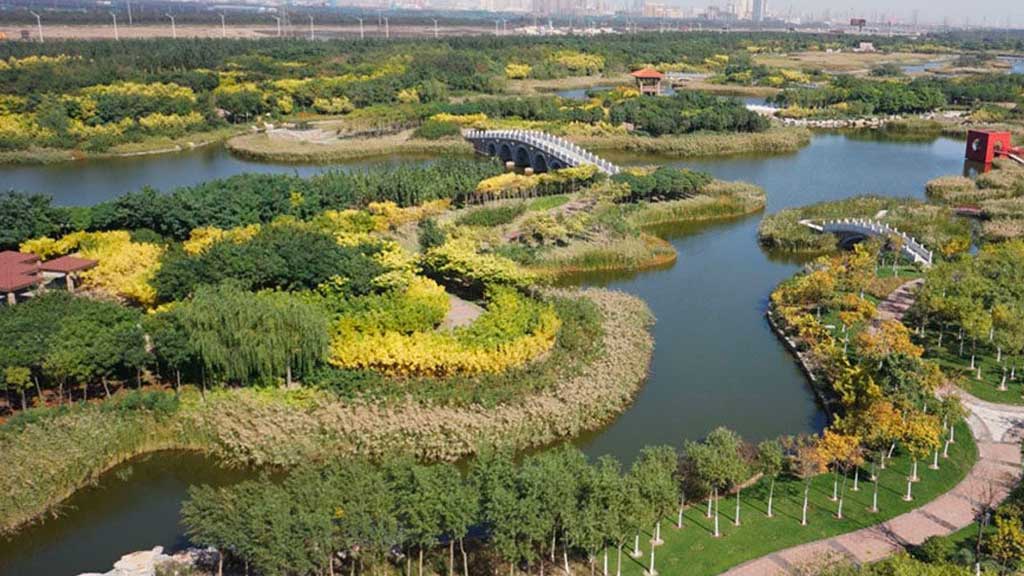
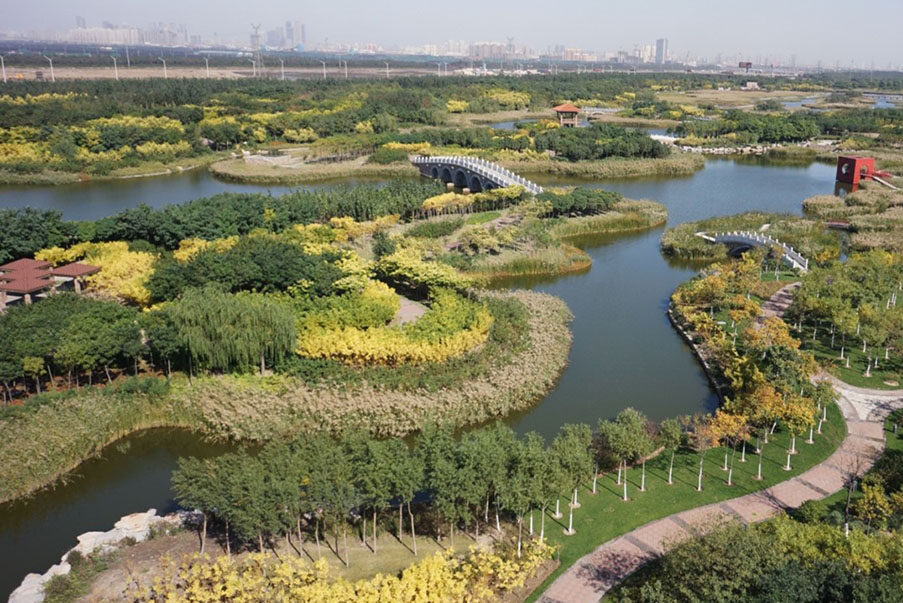
Investments include water conservation, ecosystem rehabilitation, disaster prevention, and green growth capacity development.
Overview
Tianjin Binhai New Area was established to become a center of finance, business, and industry in the northern PRC to usher further economic development. However, economic boom in the Hai River basin and the Bohai Bay coastal areas since the 1990s already resulted in significant water pollution problems and degradation of natural and environmental resources. How to achieve economic development without aggravating the environment became a critical challenge.
A project funded by ADB demonstrated sound environmental and public safety investments, such as water conservation and ecosystem rehabilitation, disaster prevention and emergency response, and enhanced institutional capacities, to improve environmental and economic conditions at the Harbor Economic Area, a functional area of the new center.
Integrating adequate environmental management practices and risk mitigation measures into development activities, including public infrastructure and industrial investments, is crucial for sustained economic development and green growth.
Project information
43054-013: Hai River Estuary Area Pollution Control and Ecosystem Rehabilitation Project in the PRC
Project snapshot
Context
The Hai River and 15 other rivers flow toward Bohai Bay, which is bounded by the coastlines of Hebei Province, Tianjin municipality, and Shandong Province.
Tianjin has a total area of 11,760 square kilometers (km2) and a population of 11.6 million. It is located at the lowest reach of the Hai River basin.
The Tianjin Binhai New Area was established in 2010 as an economic zone like Shenzhen and the Shanghai Pudong area. The Harbor Economic Area is a land reclamation site in the tidal-flat portion of Bohai Bay, south of the Hai River estuary. The area accommodates large domestic and international companies, including petrochemical industries, shipyards, offshore oil engineering bases, heavy equipment manufacturing, and technological research and development institutes. It also provides residential areas and corresponding public utilities.
Challenges
Rapid economic development in the Hai River basin and the Bohai Bay coastal areas had resulted in the degradation and scarcity of natural and environmental resources. Impacts included polluted waterways, scarcity of water resources in the river basin, and deterioration of the Bohai Sea ecosystems.
The Bohai Bay also suffered from frequent and severe storm surges that had caused severe damage to Tianjin and increased the risks of accidental pollution.
Fast development pace has overshadowed the need to integrate adequate environmental management practices and risk mitigation measures into development activities.
Shifting to sustainable development in the Harbor Economic Area, a new coastal industrial hub, became a challenge for the Tianjin municipal government. Aside from moving to cleaner or nonpolluting industries, the local government needed to improve its capacity for green development and incorporate sustainable features into public infrastructures.
Solutions
In 2011, ADB approved a $100 million loan to demonstrate sound environmental and public safety investments for sustained green growth in the coastal areas of Tianjin. The project built a sewer system and reclaimed water plant for water conservation; eco-efficient wetland for ecosystem rehabilitation; breakwater for storm surge mitigation, taking into accounts climate change impacts; and an environmental monitoring and emergency response center to offer a comprehensive platform for environmental monitoring and emergency management.
The ADB also provided a $1 million technical assistance grant to enhance the capacity of the executing and implementing agencies to pursue green growth. The technical assistance introduced international best practices on harbor and industrial park management, supported the International Organization for Standardization (ISO) certification of the government’s construction and development company, and helped establish the said emergency response center.
The project constructed a 15,000-cubic meter per day (m3/day) wastewater treatment plant (WWTP), a 10,000 m3/day reverse osmosis reclaimed water plant, 42 kilometers (km) of sewer pipelines, 21 km of stormwater pipes, and 41 km of reclaimed water pipes. A multi-functional wetland park was designed for advanced sewage treatment, water regulating, biodiversity conservation, and culture services for surrounding areas. The 63-hectare (ha) wetland with treatment capacity from Class 1B to Class 1A was constructed with low impact development feature. The effluent from wastewater treatment plants is purified by the wetland and used as landscape and greening water.
The project constructed a prevention wall (breakwater) to minimize risks and damage caused by storm surges and to ensure safe and efficient working conditions in the Harbor Economic Area. The prevention wall is about 3 km long with a once-in-50-year design standard, taking into consideration climate change impacts. An environmental monitoring and emergency response center was established to deal with pollutants and emergencies arising in the coastal industrial hub. The center holds the first comprehensive environmental monitoring and emergency management platform in Tianjin that integrates information collection and analysis, monitoring and early warning, decision support, dispatching and command, and accident handling and evaluation.
The project consultants provided advisory services and training for implementing institutions in design review, construction and procurement management, quality management, information management, and project monitoring and reporting. Manuals on low-pressure sewer system and low-impact development approaches were produced for application in the Harbor Economic Area.
The technical assistance helped the Harbor Industrial Park Construction and Development Company (HIPCDC) obtain ISO certifications on quality management and environmental management system; trained government officials on best practices in managing industrial parks and harbors; organized quantitative risk assessment and emergency response management workshops, reviewed emergency response plans of chemical and petrochemical plants, and conducted drills; and assisted in the concept design of the environmental monitoring and emergency response center.
Results
The improved wastewater treatment facilities reduced pollutant emissions. Around 59% of the treated wastewater from the treatment plants in the Harbor Economic Area is recycled for reuse; and about 37% of water supply in the Tianjin Binhai New Area come from nontraditional sources, such as reclaimed water and desalinated water, to overcome water scarcity.
The wetland park serves as a habitat for coastal species and a leisure site for citizens. Wild birds increased from 29 species in 2015 to 113 species in 2017. The wetland park also received more than 100,000 visitors as a relaxation place and an environmental education base for residents in the neighboring areas. The water quality is improved after flowing through the wetland.
The breakwater lowered the risk of storm surge losses, increased the capacity and efficiency of cargo berth, improved the safety of shipping and dock loading, and minimized maintenance dredging at docks through reduced back silting.
The environmental monitoring and emergency response center enhanced the government’s ability to respond promptly to various production and environmental pollution accidents and regulate the production and discharge behavior of enterprises in the Harbor Economic Area. The integrated analysis, proactive traffic management of hazardous vehicles, monitoring and risk detection, and emergency response plans effectively reduced the risk of accidents. Overall disaster prevention and response plans mitigate risks of the Harbor Economic Area from economic losses, injury, and environmental pollution.
HIPCDC, the government’s construction and development company, obtained ISO certifications for quality management system and environmental management system. Since 2014, the ISO-certified systems were applied to the company’s core business, including land development, municipal infrastructure development, and leasing services for the houses and public facilities in the industrial hub.
Good environmental management practices and risk mitigation measures are also integrated into non-project development activities in the area. Green growth in the Bohai Bay coastal areas of the Tianjin municipality has been gradually sustained. Eco-efficiency and recycling activities, such as the constructed wetland and reclaimed water plant, have been replicated in other coastal areas of Tianjin municipality. In 2019, the Lingang Area (the new name of the Harbor Economic Area after merging with the Tianjin Port Free Trade Zone in December 2017) was recognized as a municipality-level demonstration zone of a recycling economy. In 2020, the Tianjin Port Free Trade Zone, including Lingang Area, was identified as a state-level Green Industrial Park for green and sustainable development.
Lessons
Reclaiming treated wastewater for reuse can help overcome water scarcity. Constructed wetland can be designed to provide multiple ecological functions beyond wastewater treatment.
A comprehensive environmental monitoring and emergency management mechanism is important for pollution and disaster management of an industrial area with high environmental risks.
Holistic planning, precise design, and accurate implementation are keys for success in eco-efficient and recycling activities. The construction of the wastewater treatment plant and reclaimed water plant should be synchronized with the pace of overall industry and infrastructure development. Although it was planned so, the actual construction of the plants was delayed because of external factors. Otherwise, the financial viability of this project component would be better.
Getting government’s construction and development companies with ISO environmental management certification is also a way to quality and responsible development as this kind of certification institutionalize environmental management capacity through a systematic approach that generates wide impact. These companies are often commissioned by the government for land development and infrastructure construction in the PRC.
Enhanced capacities of institutions and staff are vital for sustaining green growth beyond the project. Knowledge and understanding of best practices widen their vision for green development, ecological and environmental protection, emergency response, and industrial park and port management. New skills and a change in mindset benefit work beyond the project and are considered as an asset to organizations.
Asian Development Bank (ADB). 2011. Report and Recommendation of the President to the Board of Directors on a Proposed Loan and Technical Assistance Grant to the People’s Republic of China for the Hai River Estuary Area Pollution Control and Ecosystem Rehabilitation Project. Manila.
ADB. 2021. Completion Report: Hai River Estuary Area Pollution Control and Ecosystem Rehabilitation Project in the People’s Republic of China. Manila.

Senior Project Officer (Natural Resources and Agriculture), East Asia Department, ADB
This blog is reproduced from Development Asia.
© 2025 Regional Knowledge Sharing Initiative. The views expressed on this website are those of the authors and presenters and do not necessarily reflect the views and policies of the Asian Development Bank (ADB), its Board of Governors, or the governments they represent. ADB does not guarantee the accuracy of the data in any documents and materials posted on this website and accepts no responsibility for any consequence of their use. By making any designation of or reference to a particular territory or geographic area, or by using the term “country” in any documents posted on this website, ADB does not intend to make any judgments as to the legal or other status of any territory or area.
